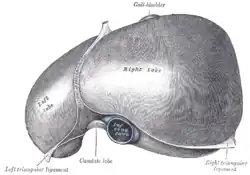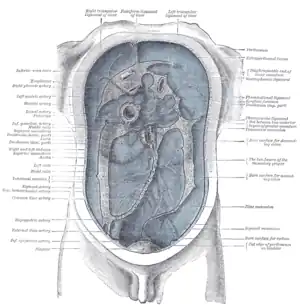Left triangular ligament
| Left triangular ligament | |
|---|---|
 The superior surface of the liver. | |
| Details | |
| Identifiers | |
| Latin | ligamentum triangulare sinistrum hepatis |
| TA98 | A10.1.02.305 |
| TA2 | 3776 |
| FMA | 76987 |
| Anatomical terminology | |
The left triangular ligament is a large peritoneal fold. It connects the posterior part of the upper surface of the left lobe of the liver to the thoracic diaphragm.
Structure
The left triangular ligament connects the posterior part of the upper surface of the left lobe of the liver to the thoracic diaphragm.[1] Its anterior layer is continuous with the left layer of the falciform ligament.
Additional images
 Diagram to show the lines along which the peritoneum leaves the wall of the abdomen to invest the viscera.
Diagram to show the lines along which the peritoneum leaves the wall of the abdomen to invest the viscera. Triangular ligament of liver.Superior surface of liver.
Triangular ligament of liver.Superior surface of liver. Triangular ligament.Diaphragmatic surface of liver.
Triangular ligament.Diaphragmatic surface of liver.
References
![]() This article incorporates text in the public domain from page 1193 of the 20th edition of Gray's Anatomy (1918)
This article incorporates text in the public domain from page 1193 of the 20th edition of Gray's Anatomy (1918)
- ↑ Mirilas, Petros; Skandalakis, J. E. (September 2002). "Benign anatomical mistakes: right and left coronary ligaments". The American Surgeon. 68 (9): 832–835. ISSN 0003-1348. PMID 12356161.
External links
- liver at The Anatomy Lesson by Wesley Norman (Georgetown University) (liversuperior)
- Anatomy photo:38:10-0103 at the SUNY Downstate Medical Center - "Stomach, Spleen and Liver: Ligaments of the Liver"
- Anatomy image:7872 at the SUNY Downstate Medical Center
This article is issued from Offline. The text is licensed under Creative Commons - Attribution - Sharealike. Additional terms may apply for the media files.